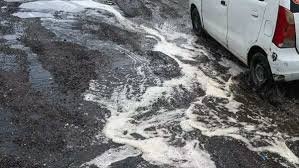A road that should connect, now divides through neglect
In the middle of South Delhi’s industrial and residential sprawl lies Maa Anandamayee Marg, a vital 4.5 km stretch that connects Crown Plaza to the Tekhand landfill. But what should function as a smooth arterial road for commuters, workers, and emergency services has now become a case study in urban decay — one where sewage flows freely, chemical waste mixes with stormwater, and public health hangs in the balance.
For locals and daily commuters, the road is no longer a passage — it’s a hazard. The putrid smell of industrial effluents hangs thick in the air, and black water overflows onto the carriageway, making even walking near it difficult. This isn’t a recent development. Residents and small business owners along the corridor say the problem has been growing for well over a year, with no permanent solution in sight.
What exactly is happening on Maa Anandamayee Marg?
At its core, the issue is a collapsed or dysfunctional sewage and drainage system. In multiple stretches along the road, wastewater from nearby industries, combined with sewage from unauthorized settlements and colonies, flows openly over the surface of the road. The result is a near-permanent waterlogging condition with high chemical content and visible sludge — especially during and after monsoon spells.
Motorists often avoid the road entirely, fearing tire damage, accidents, and health exposure. Pedestrians hold cloths over their noses or detour through other lanes. The road, which also services garbage trucks moving in and out of the Tekhand landfill, now resembles a neglected canal more than a functional roadway.
Why it matters: more than a local inconvenience
The significance of Maa Anandamayee Marg’s condition goes far beyond traffic delays or inconvenience. It highlights three deeply rooted urban crises in Delhi:
- Sewage-Stormwater Integration Failure: Across Delhi, many areas lack proper separation between sewage pipelines and stormwater drains. This leads to frequent overflows, especially in industrial areas like Okhla.
- Environmental Risk: Chemical waste entering the open environment from nearby manufacturing units increases the risk of groundwater contamination and airborne illnesses — especially for those living in proximity without proper filtration.
- Municipal Accountability: Residents report that complaints to the Delhi Jal Board (DJB) and South Delhi Municipal Corporation (SDMC) have gone unanswered or have only led to temporary patchwork interventions.
Daily life disrupted: voices from the ground
“We can’t even open our shop shutters without spraying phenyl first,” says Rakesh Gupta, a hardware shop owner whose storefront faces one of the worst-affected stretches. “The smell is unbearable, and customers refuse to park here anymore.”
“During school drop-offs, we hold our children above the water like a ritual. They ask if this is sewage or a river,” shares Anamika Verma, a local resident from Harkesh Nagar.
For street vendors, rickshaw drivers, factory workers, and the elderly who frequent this corridor, the road is now a source of daily suffering — not just inconvenience.
What has been done so far?
While some short-term pumping operations and drain cleaning initiatives were launched after heavy rainfall earlier this year, they’ve failed to offer a sustainable solution. According to environmental groups tracking South Delhi’s civic infrastructure, this stretch needs:
- Dedicated drain replacement and realignment to separate sewage and stormwater
- Strict enforcement on industrial effluent disposal
- Periodic inspections by civic bodies and Jal Board engineers
- Monitoring through real-time water sensors in high-risk pockets
However, no major tender or repair contract has yet been sanctioned for Maa Anandamayee Marg’s restoration, despite multiple media reports, including citizen complaints covered earlier in 2024.
What users are searching for — and not finding
People are turning to search engines with queries like:
- “Why is Maa Anandamayee Marg waterlogged?”
- “Maa Anandamayee Marg sewage complaint Delhi”
- “Okhla road smell and water problem”
- “How to report sewage overflow in South Delhi?”
Unfortunately, many of these searches don’t yield actionable results or verified updates. There’s a gap in transparency, and that’s adding to public frustration.
Can this be fixed — and how soon?
Urban planners agree that the fix is possible, but only if it’s prioritized. A multi-agency response from DJB, Delhi Pollution Control Committee (DPCC), PWD, and local MLAs is required — not just to repair physical drains but to redesign the area’s entire waste management approach.
In the short term, even mobile treatment units, covered drains, and regular jetting machines could ease the crisis. But without a clear, public roadmap, Maa Anandamayee Marg may continue to rot — right in full view of the city.
Why it matters for the rest of Delhi NCR
Maa Anandamayee Marg is not just another forgotten stretch. It’s emblematic of the silent collapse happening in many of Delhi’s “backdoor” industrial corridors — where businesses thrive, but basic civic upkeep doesn’t. And unless it is addressed urgently, the problems of Okhla today could become the problems of Greater Kailash, Lajpat Nagar, or Faridabad tomorrow.
FAQs: Maa Anandamayee Marg Sewage Overflow & Road Condition (2025)
Q1. Where exactly is Maa Anandamayee Marg located in Delhi?
Maa Anandamayee Marg is a major 4.5 km road stretch located in South Delhi. It runs between Crown Plaza (Okhla Phase I) and the Tekhand landfill, and serves as a key access road for industrial areas, residential neighborhoods, and landfill operations.
Q2. Why is Maa Anandamayee Marg always waterlogged and smelly?
The road is waterlogged due to a failed drainage and sewer system, which causes untreated sewage, industrial effluents, and stormwater to overflow directly onto the surface. The open discharge of chemical-laced wastewater has led to constant foul odors and health concerns.
Q3. Is the water on Maa Anandamayee Marg sewage or rainwater?
It’s primarily sewage mixed with chemical waste and some stormwater. Residents and shopkeepers report blackish water with visible sludge, indicating untreated sewage rather than just rain accumulation.
Q4. Who is responsible for fixing the sewage problem on Maa Anandamayee Marg?
Multiple agencies share responsibility, including the Delhi Jal Board (DJB) for sewage management, South Delhi Municipal Corporation (SDMC) for local sanitation, and the Public Works Department (PWD) for road infrastructure. Coordination between these bodies has been lacking.
Q5. Has any action been taken by the government to resolve this issue?
Only temporary de-watering and drain cleaning efforts have been made in response to public complaints and media attention. No long-term sewage realignment or infrastructure project has yet been announced for Maa Anandamayee Marg.
Q6. How long has the sewage overflow issue been going on?
Local residents report that the problem has existed for over a year, gradually worsening due to lack of maintenance, increased chemical discharge from factories, and poor monsoon drainage systems.
Q7. Is it safe to drive or walk on Maa Anandamayee Marg right now?
No, the road is partially submerged in sewage water in many places, making it unsafe for pedestrians and risky for two-wheelers or cars. The chemical nature of the water may also pose health hazards on skin contact or inhalation.
Q8. How can I report the sewage overflow or road condition to authorities?
You can register complaints via:
- Delhi Jal Board: 1916 or online grievance portal
- SDMC (South Delhi Municipal Corporation): 155305
- Delhi Government Grievance Portal: pgms.delhi.gov.in
Q9. Are there other roads in Delhi facing similar sewage or drainage issues?
Yes. Roads in industrial zones like Ghazipur, Wazirpur, Okhla Industrial Area, and parts of Kirti Nagar frequently suffer from similar sewage overflow and drainage mismanagement, especially during monsoons.
Q10. Is this affecting air quality or groundwater in Okhla?
Yes. Open sewage discharge increases ammonia levels in the air, worsens indoor air pollution, and poses risks of groundwater contamination for areas dependent on shallow borewells.
Q11. Can this issue be fixed permanently?
Experts suggest that it can — but only through a long-term integrated drainage plan, sewage line realignment, stricter industrial effluent enforcement, and multi-agency coordination between DJB, SDMC, and PWD.

